Three Heroines of Magic
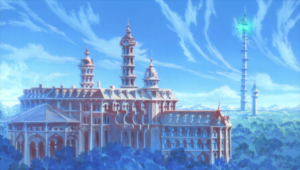
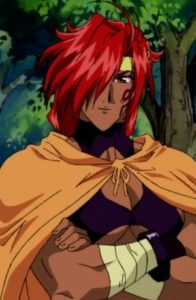
Curvy but otherwise just a fighter
Years ago, when the term “strong female character” first appeared, we all knew what it meant—that the female characters had a real place in the story, that they weren’t just along on the adventure to cook dinner. As time has gone on, however, the term has become confusing, as “strong female characters” have been portrayed as woman who is strong physically. Sadly, female characters who can bash heads with sheer physical strength often have very little in common with real women, other than their shape. They are basically women-shaped men.
But the question arises: if she doesn’t solve her problems with a boot to the head, how is our heroine going to hold her own during an adventure?
Enter: magic!
Magic allows a character to rely on something other than brute strength and yet still char the baddie. But it also opens the way for problems to be solved with cleverness or even kindness. To that end, here are three magic-wielding heroines from TV shows who are particularly appealing.
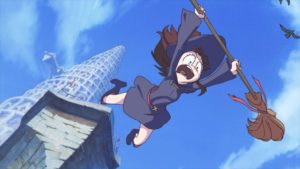
Flying is more difficult than it looks
Atsuko Kagari, known as Akko from Little Witch Academia – Akko is a young Japanese girl who, at the age of six, falls in love with magic at a performance given by a witch named Shiny Chariot. Determined to become a witch, as soon as she is old enough, she travels all the way to England to enroll at Luna Nova, a prestigious girls’ school for witches.
When she arrives, she discovers that all the other students are from witch families and have been studying since they were children. Akko knows nothing about magic when she arrives and cannot do even simple things, such as cast a simple spell or fly on a broom.
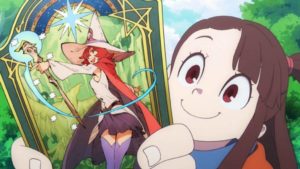
Shiny Chariot!
And yet, Akko won’t give up. She is determined to become a great witch and bring magic back to the world in general, so that everyone can appreciate the wonder of it—and nothing stops her. Not her own inability, not the dwindling nature of magic, not more experienced rivals, not conniving politicians.
Strangely, thought, despite her tenuous state due to her inability to perform the magic, Akko also can’t seem to obey rules. She is forever poking into something she’s been told not to poke into, leaving campus when she’s been told to stay put, and, in general, causing chaos wherever she goes.
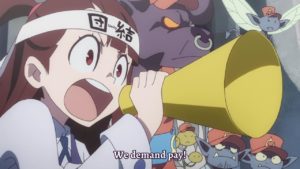
Akko goes to speak to the staff during a strike and ends up joining their side.
And yet, she manages to slowly win over her skeptical roommates, her rivals, teachers, towns members, even an aristocratic boy, who occasionally visits the school.
What wins them over? Her courage, her fixity of purpose, her perseverance, her faith in her friends, and her general outgoingness.
All these qualities combine to make her a very appealing heroine!
(Little Witch Academia, an anime, is available on Netflix.)

Mildred on Maud’s broom for the first time
Mildred Hubble from Worst Witch – Mildred Hubble from the BBC/Netflix’s series Worst Witch has a slightly different origin than her counterpart in the original Worst Witch book series (reviewed on this website here.) TV Mildred is a girl who can see a distant castle that no one else sees, only, she’s not aware that no one else sees it. Turns out, she has magic, and the castle is a magic school. Mildred finds this out because she helps another witch, pudgy but smart Maud, on her way to school at the beginning of the term. Maud talks Mildred into coming along.
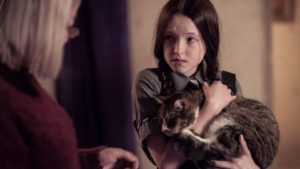
Everyone else’s cat is black
Arriving at Miss Cackle’s Academy for Witches, it is discovered that Mildred is a witch. The school convinces her mother to let Mildred go to boarding school, and trouble begins to brew!
Like Akko above, Mildred is an outsider with no training among students from families that have had magic for generations and, like Akko, she has a perchance for getting herself into trouble. However, in Mildred’s case, the trouble is less likely to initially be her fault. She wanders into the wrong place at 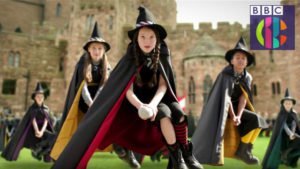 the wrong time. Her new friend plays tricks that get her into trouble. She is given a cat with no sense of balance. True, she makes her own mistakes, but haplessness does figure into a number of her mishaps.
the wrong time. Her new friend plays tricks that get her into trouble. She is given a cat with no sense of balance. True, she makes her own mistakes, but haplessness does figure into a number of her mishaps.
But these very mishaps help build character as Mildred strives to recover from her many misadventures. Mildred is brave. She’s also alert. She notices things others don’t see. For instance, when the good headmistress is replaced by her evil twin, Mildred is the one who notices the little things the twin does wrong. In fact, this was one of the pleasures of the show: that Mildred notices things when things go wrong, sometimes right away.
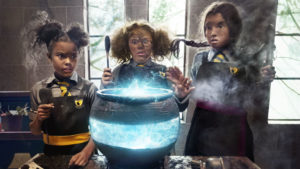 Unfortunately, when she tries to tell others, she is not always believed—or in a position to be believed, such as when she was stuck as a frog!
Unfortunately, when she tries to tell others, she is not always believed—or in a position to be believed, such as when she was stuck as a frog!
Seeing Mildred use her cleverness to outwit her enemies is one of the great pleasures of watching the excellent show Worst Witch.
(Worst Witch is available on Netflix.)
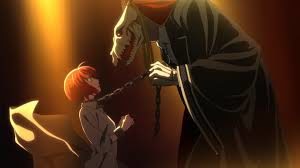
Elias buys Chise
Chise Hatori from Ancient Magus’ Bride – Se, as the heroine of the anime Ancient Magus’ Bride is often called, is a very different kind of character from spunky Akko and resourceful Mildred. At the beginning of the first episode, she has just sold herself to a magical action house to be auctioned off as a slave. Se, a red-headed Japanese girl, can see spirits, and this is not a happy thing. Many of the things in the spirit world are ugly or terrifying. She has lived a sad lonely world, since her mother committed suicide, and has no hope.
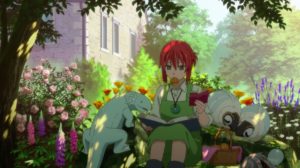
Beloved of the “neighbors”
Chise is purchased by a half-fairy creature named Elias who has a skull for a head. This being recognizes her as someone whom fairies (neighbors, he calls them) love. He explains that he plans to teach her magic and to make her his bride. He brings her to England to live with him in his cottage, which is maintained by a silky, a kind of fairy woman. (I wonder if, due to Harry Potter, the Japanese associate the British Isles with magic.)

This show has the most beautiful landscapes
The fairies do love Chise. They even offer to take her to fairyland, away from human troubles. When she says no, because she feels a loyalty to Elias, the first being who has ever showed concern for her or wanted to give her a home, she takes her first step towards leaving behind her past and becoming a very different person from the hollow shell she once was.
As the story continues, Se blooms. She begins to make her own choices, and what she chooses is gentleness, love, kindness, sweetness and other extremely 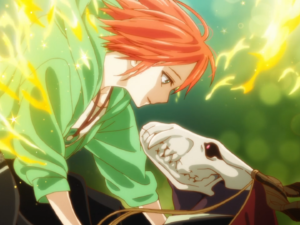 feminine responses. And yet, these qualities give her such strength as she faces down dangers and finds happier outcomes using love and loyalty.
feminine responses. And yet, these qualities give her such strength as she faces down dangers and finds happier outcomes using love and loyalty.
The sweetness of the main character as she leaves her past behind combined with the sheer beauty of the lyrical English countryside and of London, as portrayed in the series, makes the show absolutely enchanting.
(Ancient Magus’ Bride is available on Crunchyroll)
While all three of these heroines are very different in mood and character, each show offers a delightful experience immersing oneself into a world of magic. All three girls use both their powers and their courage, cleverness, and goodness of heart to solve their problems, in a gentle, thoughtful, and thorough way that never would have arisen had they settled their troubles by bashing heads.
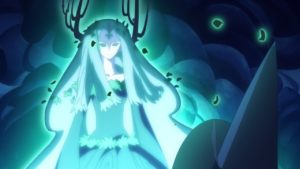

Miazaki had a lot of these too.
Maybe we’re finally coming to the end of the galbrush paradox. (explanation about what it is posted below)
I have been thinking quite a bit about the “Same description, different sex” and how that changes things.
Funny thing is, you used to be able to have inept women…wasn’t that part of the whole charm of I Love Lucy, a show beloved of a whole generation.
Miyazaki does have a lot of them. Another time, I could talk about Kiki. I am also looking forward to seeing Mary and the Witch Flower, which…while not Miyazaki, is from someone he mentored.